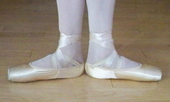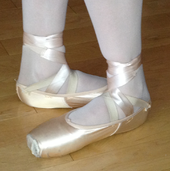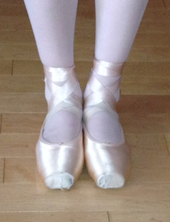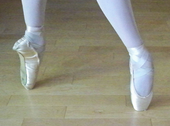The positions of the feet in ballet is a fundamental part of classical ballet technique that defines standard placements of feet on the floor. There are five basic positions in modern-day classical ballet, known as the first through fifth positions. In 1725, dancing master Pierre Rameau credited the codification of these five positions to choreographer Pierre Beauchamp. Two additional positions, known as the sixth and seventh positions, were codified by Serge Lifar in the 1930s while serving as Ballet Master at the Paris Opéra Ballet, though their use is limited to Lifar's choreographies. The sixth and seventh positions were not Lifar's inventions, but revivals of positions that already existed in the eighteenth century, when there were ten positions of the feet in classical ballet.
Five basic positions
The first basic position requires the feet to be flat on the floor and turned out (pointing in opposite directions as a result of rotating the legs at the hips).
First position

Heels together, and toes going outwards.
Second position

The feet point in opposite directions, with heels spaced approximately 12 inches (30 cm) apart
Third position

One foot is placed in front of the other so that the heel of the front foot is near the arch of the rear foot.
Fourth position


There are two types of fourth position: ouverte and croise. In both cases, one foot is placed approximately 12 inches (30 cm) in front of the other. In open fourth position the heels are aligned, while in closed fourth position the heel of the front foot is aligned with the toe of the back foot.
Fifth position

In fifth position, the feet are parallel, with the heel of the front foot in contact with the big toe of back foot, and the heel of the back foot in contact with the last toe of the front foot.
Lifar's additional positions
Serge Lifar (1905–1986) codified two additional positions known as the sixth and seventh positions, with the feet turned in, not out like the first five positions.
Sixth position

In Lifar's sixth position, the legs are turned in with the feet side-by-side and parallel.
Seventh position

Similar to fourth position, but performed en pointe with heels in center with each other. There are two seventh positions, determined by whether the left or right foot is placed in front.
See also
References
- Harris-Warrick, Rebecca; Brown, Bruce Alan (2005). The Grotesque Dancer on the Eighteenth-Century Stage. University of Wisconsin Press. p. 115. ISBN 978-0299203542.
- Lifar, Serge (1951). Lifar on Classical Ballet. Allan Wingate. ASIN B0006ASYP2.
- Ries, Frank W. D. (1986). The Dance theatre of Jean Cocteau. Ann Arbor: University Microfilms International Research Press. p. 132. ISBN 0-8357-1994-4.
- Paolacci, Claire (2004). "Serge Lifar and the Paris Opera during World War II". Journal of the Oxford University History Society: 8.
- Craine, D.; Mackrell, J. (2010). The Oxford Dictionary of Dance. Oxford Paperback Reference. Oxford University Press. p. 171. ISBN 978-0-19-956344-9. Retrieved April 17, 2024.
| Ballet | |
|---|---|
| General information | |
| Terminology | |
| Ballet by genre | |
| Ballet by region | |
| Technique |
|
| Occupations and ranks | |
| Ballet apparel | |
| Awards | |
| Organisations | |
| Publications | |
| Related articles | |
| |